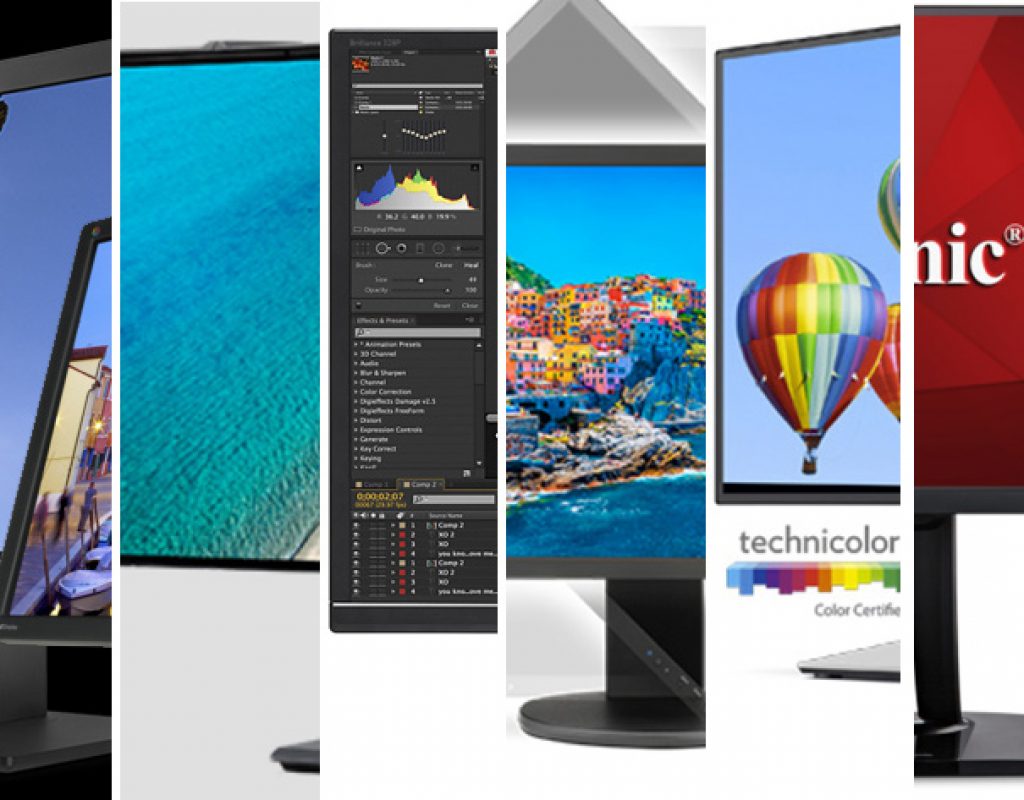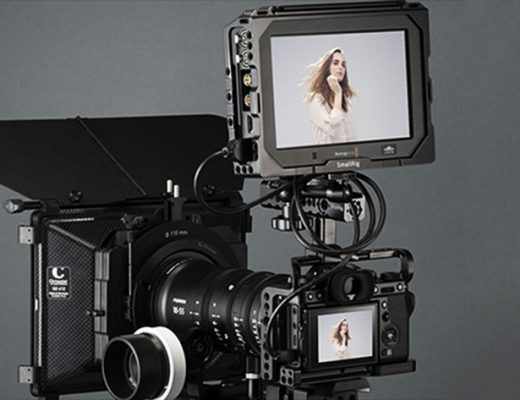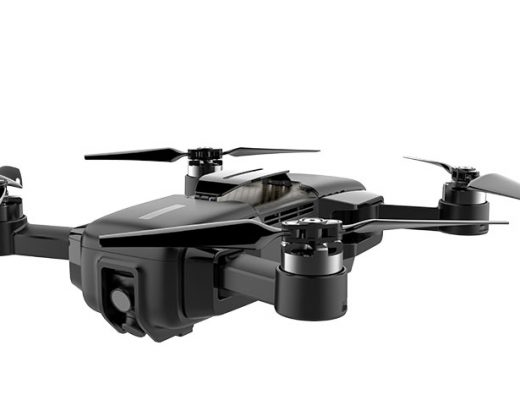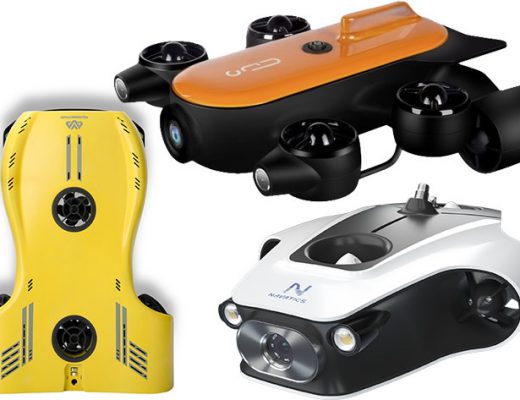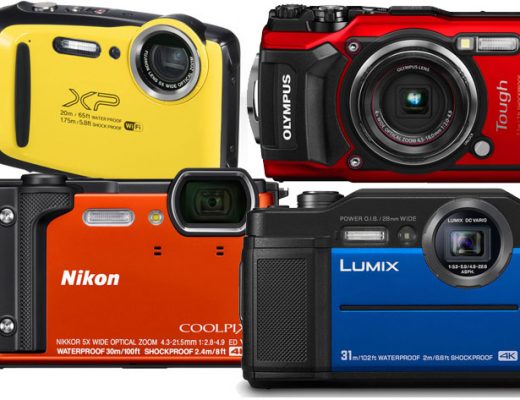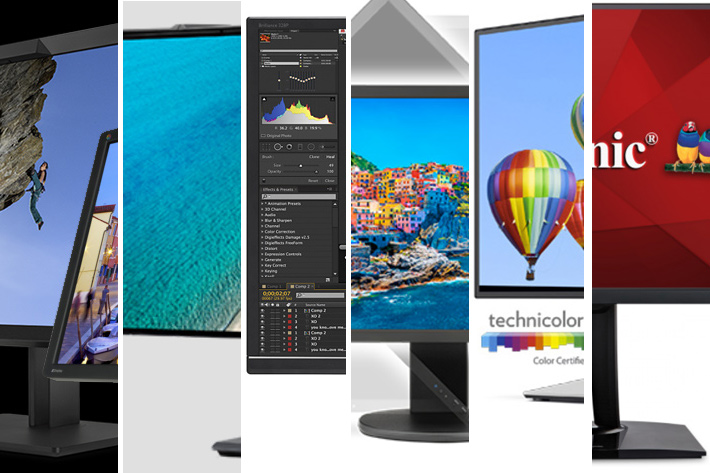
Video editors and photographers need high quality monitors to clearly visualize their work, but that does not mean they need to spend a fortune on their next monitor. Here are some monitors you should probably check.
The best advice when buying a monitor is… don’t buy from catalog. In fact, no matter how much you read reviews and check online videos, you should always try to see the real monitor before buying it. If a monitor is an essential element of your work, you’ll be starting at it for many hours, so having a monitor that you feel comfortable with is the first step. It’s not just the colour, brightness, detail, it’s everything else, from the way the display can be tilted, turned around, to the interface and controls.
Resolution continues to be an essential element when choosing a monitor, but when buying a monitor it is important to know if the system it is going to be used with can cope with higher resolutions. While having more desktop space is always a good thing, there has to be a compromise between that and the power the computer/graphics card has. The Philips 328P6AUBREB mentioned in a previous article is an example of compromise, has it has a resolution of 2560×1440 on a 32 inch screen, when most guides will suggest that a 32 inch screen should have 3840×2160, or 4K UHD. Both are 16:9, which is somehow the most common aspect ratio, but there is a difference. It’s up to you to decide EXACTLY your needs.
Whatever you do, buying the biggest size you can use on your desktop is a good solution. When it comes to size, unless you need a monitor you can easily take with you, 27-inch monitors seem to be the smallest acceptable, according to some. 27-inch with a resolution of 2560×1440 (WQHD) are, apparently, the “norm”. You’ll also find some 24-inch monitors with the same resolution – and others, like the 32-inch from Philips – but usually screen size and resolution go hand-in-hand, meaning a 27-inch is 2560×1440, a 30 or 32-inch is 3840×2160 or, in extreme cases, the DCI 4K, that’s 4096×2160.
In terms of panels, IPS, which stands for In-Plane Switching, is considered the way to go. It comes in different flavours and under different names, but as long as the panel is IPS, color reproduction will be good enough for professional work. Colour being an essential aspect, the color gamut covered is also a key element to check. Most monitors will claim they offer at least 99% SRGB colour gamut, which is fine for a lot of work, but look for 99% Adobe RGB or beyond if available. Monitors supporting wide gamut RGB cost more.
This guide does not pretend to be exhaustive, more a compilation of suggestions that may help you find a solution if you’re after your first monitor or, like me, you’re looking for a replacement to a dying monitor.
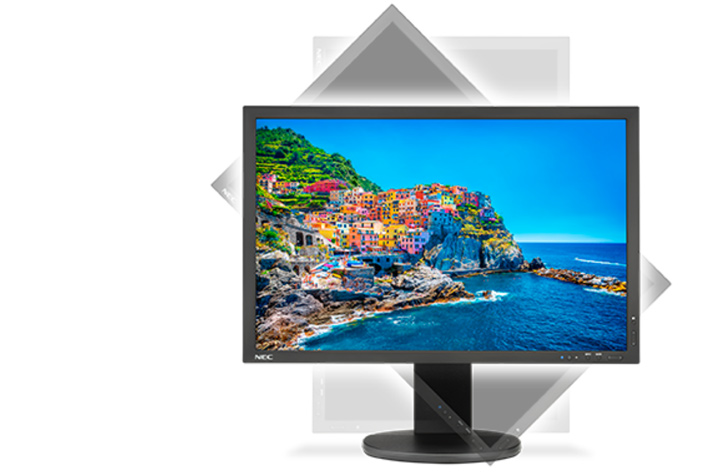
NEC MultiSync PA243W for $949
NEC recently updated the PA242W, one of its “most popular professional wide color gamut desktop displays,” according to Art Marshall, Senior Product Manager for Desktop Displays at NEC Display Solutions. The new monitor, reference PA243W, offers “new cutting-edge features have been added to provide improved color coverage to meet the color-critical needs of the print production, digital photography, photo editing, and video production markets, among others.”
The MultiSync PA243W has a 24.1″ IPS panel with LED backlight with a great viewing angle and anti-glare matte finish. Its premium color accuracy is ideal for color-critical workflows and in photography, video, printing and other professional environments. It increases Rec. 2020 coverage and boosts color accuracy to an impressive 99.6 percent of Adobe RGB, according to NEC. One note: this is a 24-inch 1920 x 1200 monitor, offering a 16:10 aspect ratio.
This model offers multiple connections for any application: a fast USB 3.1 hub featuring DisplaySync Pro KVM switch for managing multiple computers, plus DisplayPort, DVI-D, VGA and HDMI. With a 31 percent slimmer design than the previous model as well as integrated speakers and a new Low Blue Light setting.
The PA243W-BK with a black cabinet is available at a minimum advertised price of $949, and a white cabinet (PA243W) is also available. In addition, both colors are available bundled with NEC’s award-winning SpectraViewII color calibration software and sensors as PA243W-SV (white) and PA243W-BK-SV (black) at a price of $1,199.
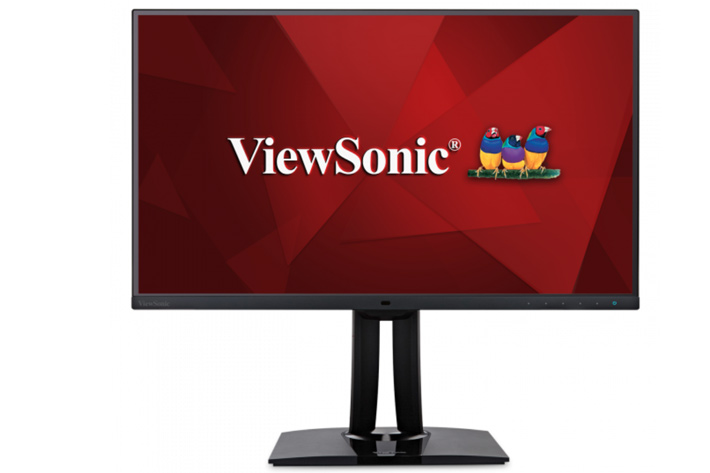
ViewSonic VP2785-4K for $989
Color accuracy, with 99 percent Adobe RBG and 98 percent DCI-P3 colors, brightness, chromaticity and tone stabilized in mere minutes are some of the features of the new 27-inch 4K UHD (3840×2160) monitor from ViewSonic.
Built to deliver, says the company, unmatched color accuracy for professional color-critical applications, the ViewSonic VP2785-4K ensures vibrant and intense color reproduction, making this monitor the perfect display solution for photographers, video and content producers and editors.
With a built-in backlight sensor, the VP2785-4K can stabilize color in just three minutes, maintaining Adobe RGB and sRGB brightness stability for longer periods of time. Instead of the typical 30 plus minutes for a monitor to stabilize its brightness, chromaticity, and tone characteristics, the VP2785-4K has shortened the warm-up time to mere minutes.
From Broadcast and Cinema Presets for EBU, Rec.709, SMPTE-C and DCI with ready color spaces and gamma values, as well as Film Mode for smoother video playback, the VP2785-4K also supports HDR10 (High Dynamic Range) content decoding and playback. Skilled creative professionals will appreciate the built-in ambient light sensor, presence sensor, and KVM switch, which provide superior screen performance.
“The ViewSonic VP2785-4K was built for the professional photographer, content creator, videographer, graphic artist, or anyone that deals with color critical applications,” said Kenneth Mau, senior product marketing manager at ViewSonic Americas. “With the VP2785-4K, we offer color uniformity and accuracy. From a 10-bit panel, 14-bit LUT and 6 Axis color adjustability, connectivity options, a frameless design and newly designed ergonomic stand, this monitor delivers color coverage and output performance. The VP2785-4K is ideal for MacBook work stations or environments that need reliable color representation and image performance that is compatible with Type-C connectivity and 4K content.”
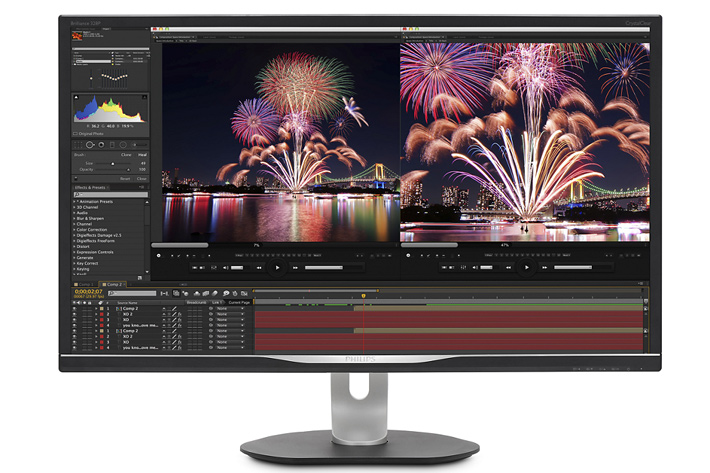
Philips 328P6AUBREB for $499
The 32-inch 2560×1440 monitor from Philips may not suite those aspiring for 4K, but is, nonetheless, an option to consider if you want to have more working space but do not have a computer ready to go all the way to higher resolutions. The compromise of WQHD on a 32-inch display may not be for everybody, but photographers or even videographers not working on 4K might consider this, also because of its price.
According to Philips, with 99% Adobe RGB and 100% sRGB (CIE 1973), the 328P6AUBREB offers professional colour standards and 2560 x 1440 pixels deliver crystal-clear images and makes graphics come alive. Thanks to IPS technology, the monitor can be viewed from an angle of 178° without losing any of the colour accuracy or consistent brightness that professional applications demand.
Follow the link for more information about the Philips 328P6AUBREB.
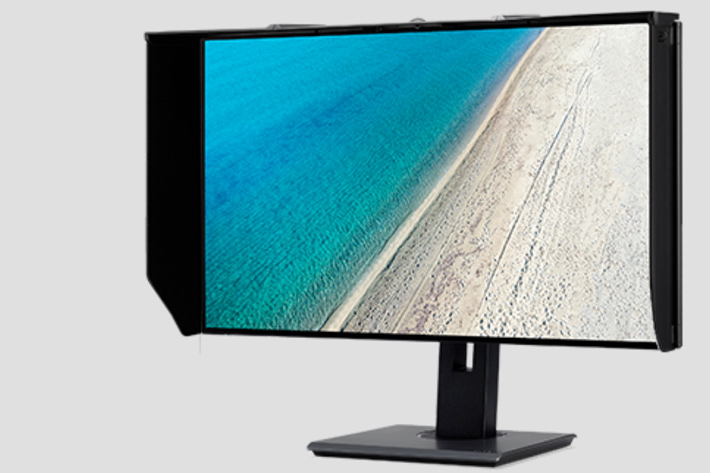
Acer ProDesigner PE320QK for $1199
Introduced this month in the United States, the Acer ProDesigner PE320QK is a 31.5-inch monitor offering 4K UHD (3840 x 2160) visuals, precise color reproduction and an adjustable shading hood to meet the needs of photographers, video editors and graphic designers.
“Engineered for professionals who require the most exacting quality standards, our latest ProDesigner monitor offers the most accurate color available today,” said Ronald Lau, director – stationary computing. “We’re confident animators, film producers and other creative experts will be delighted with the performance the Acer ProDesigner PE320QK affords.”
The Acer ProDesigner PE320QK touts a color depth of 1.07 billion colors. Boasting Delta E<1 color accuracy, the smallest color difference the eye can see, this premium monitor enables graphics professionals to fine-tune images with optimal precision. It covers 130 percent of the sRGB color standard for storing, producing and presenting a wide range of hues. Video editors, animators and directors will appreciate that it covers 95 percent of the DCI-P3 color space, the standard format for HDTVs. It ensures every hue is authentically represented, critical during post-production work and color-critical projects. Boasting 6-axis color adjustment, it lets pros obtain the exact shade they prefer by providing the ability to adjust hue and saturation, while super sharpness technology optimizes the quality of even low resolution images by slightly enhancing the edges.
An adjustable three-sided shading hood with anti-glare material reduces screen glare from ambient light, so subtleties of color can be viewed. To suit the needs of the moment, the side panels can be swiveled wider or narrower, while the upper panel can be removed.
The Acer ProDesigner PE320QK has two 2W speakers and comes with a powerful USB-C port delivering ultra-fast data and high-res video transfer with just one port. Boasting an output of 85W, it can easily charge smartphones and other devices. Other options include two HDMI 2.0 with one offering MHL 2.1, DisplayPort 1.2, audio out and a USB 3.0 hub x4 (1 up/ 4 down) for connecting to a wide array of laptops and desktops. Estimated selling prices begin at $1199.
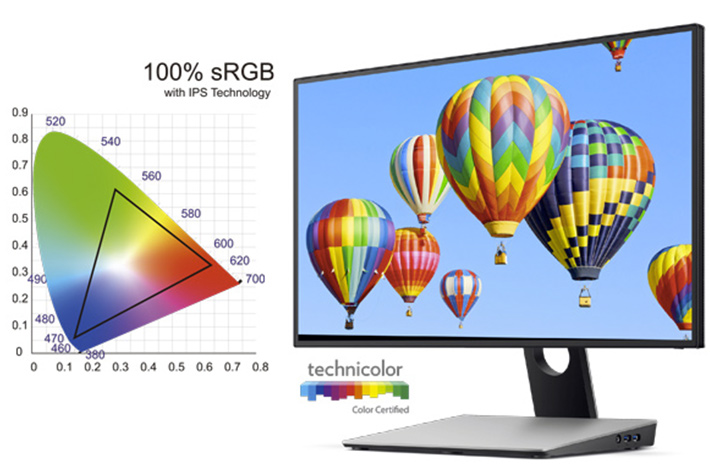
BenQ PD2710QC for $599
The first BenQ monitor with USB-C Docking Station is also a solution for professionals, as it offers 100% sRGB and Rec.709 color spaces and a wide viewing angle. The BenQ PD2710QC is Technicolor Color Certified, ensuring consistent and accurate colors for an impressive color performance, says the company.
The BenQ Designer Monitor PD2710QC is a 27″ 2K QHD (2560×1440) monitor, the first from the company to offer a range of connectivity options without having the inconvenience of cables and a separate docking station. With Darkroom, CAD/CAM and Animation display modes, the monitor can be adjusted to your specific needs. In Animation mode, the brightness on dark areas of the image is enhanced without over-exposing bright image areas, with 10 levels of display brightness available so you can see every detail clearly in any ambient lighting. Darkroom mode adjusts the brightness and contrast of images giving clarity and sharpness to details, creating the optimal setting for work in darker post-processing environments.
The monitor supports Eye-care technology and the screen can be shared through desktop partition. With BenQ’s proprietary Display Pilot software it is possible to split your screen into multiple windows.
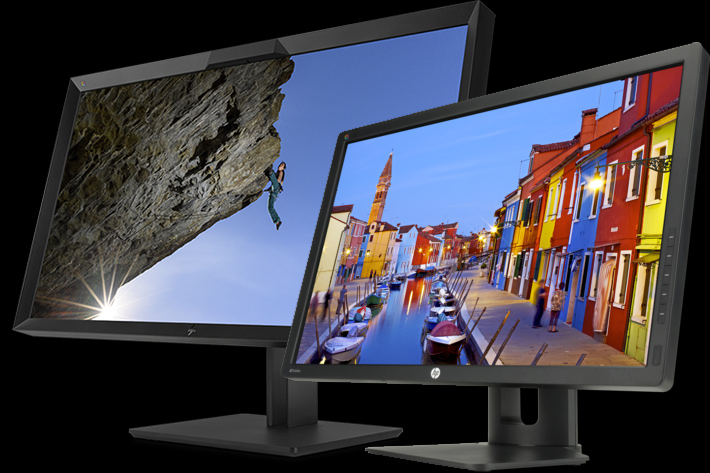
HP DreamColor for $559 or $3999
Introduced at NAB 2017, the HP DreamColor Z31x Studio and HP DreamColor Z24x G2 displays offer artists, photographers and filmmakers the right monitors to do what they do best – create – without having to worry about lackluster display performance. They come in two packages.
The DreamColor HP Z24x G2 is HP’s most affordable DreamColor display and an example that you don’t need to pay thousands of dollars to get a monitor that delivers the color accuracy and consistency that has become synonymous with the HP DreamColor brand. HP says that this display allows every artist to have a professional color accurate display on their desks.
The 24-inch IPS panel offers a 1920 x 1200 resolution (16:10 aspect ratio), wide viewing angle, 8-bit+FRC colour depth and a colour gamut covering 100% sRGB, 100% BT.709, 99% Adobe RGB and 96% DCI-P3. Pure, consistent color accuracy from design to production with color calibration on the amazingly affordable display are promised, and calibration software for both Windows and macOS supporting both the X-Rite i1Display Pro and the Klein Instruments K10-A colorimeters. The price is $559.
The HP DreamColor Z31x Studio , which aims for the other end of the scale, is not yet available, so it may be difficult to get it in time for Christmas. The 31-inch IPS panel features DCI 4K, that’s 4096 x 2160 resolution, while offering true 10-bit colour depth and a colour gamut covering 100% sRGB, 100% BT.709, 100% Adobe RGB, 99% DCI-P3 and 80% BT.2020.
“From the purest black to the most vivid rainbow of colors, our new DreamColor display for Cinema sets the gold standard for color accuracy and ease-of-use at a disruptive price point to outshine the competition,” said Josh Peterson, vice president of product management Z Workstations, HP Inc. “The new DreamColor Z Displays will be a gamechanger for studios and digital creatives who rely on color-critical accuracy and extreme performance.”
Offering precise image quality from any viewing angle, reliable and accurate color with an advanced built-in colorimeter capable of measuring and adjusting on-screen performance automatically or at scheduled intervals or on demand, and workflow accelerating features that allow users to create in Cinema 4K resolution, view in True 2K, and speed projects from concept to completion with onscreen markers and keyboard-based input switching between devices, the HP Z31x DreamColor Studio Display will cost, when available, somewhere close to $3999.
Final notes
This guide to some of the options available or soon to be available on the market may be all you need to start your own search for a new monitor. Previous articles published here at ProVideo Coalition throughout the year may give you some more suggestions, so we link to some of those articles.
BenQ AQCOLOUR: new technology for professional monitors
BenQ debuts professional line of monitors factory-calibrated

Filmtools
Filmmakers go-to destination for pre-production, production & post production equipment!
Shop Now